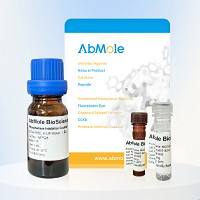All AbMole products are for research use only, cannot be used for human consumption.

Glucose-6-phosphate dehydrogenase is used to convert p-glucose-6-phosphate to p-glucono-d-lactone-6-phosphate in presence of NADP+ or NAD+. Glucose-6-phosphate dehydrogenase can be used along with hexokinase in the determination of glucose from mice liver samples. Glucose-6-phosphate dehydrogenase has been used in a study to investigate the effect of dehydroepiandrosterone on cell growth and mitochondrial function in TM-3 cells. Glucose-6-phosphate dehydrogenase has also been used in a study to investigate the incidence of apoptosis and transcript abundance in bovine follicular cells. Glucose-6-phosphate dehydrogenase is used to test ketose reductase activity in developing maize endosperm.
| CAS Number | 9001-40-5 |
| Form | Powder |
| Solubility (25°C) | Water 10 mg/mL |
| Storage | -20°C, sealed |
| Related Enzymes & Coenzymes Products |
|---|
| Creatine phosphokinase (rabbit muscle)
Creatine phosphokinase is an organ-specific enzyme that is mainly found in skeletal muscle, cardiac muscle, and brain tissue. Creatine phosphokinase (CPK) catalyzes the reversible reaction of creatine and ATP to form phosphocreatine and ADP. Creatine phosphokinase is a key enzyme for maintaining a constant ATP/ADP ratio during rapid energy turnover. |
| Glucose isomerase
Glucose isomerase can catalyze the reversible isomerization of D-glucose and D-xylose into D-fructose and D-xylulose, respectively. |
| β-Galactosidase (from Aspergillus oryzae)
β-Galactosidase acts on the terminal β-D-galactosyl moieties of disaccharides, glycoconjugates, and polysaccharides. It is useful in mediating transglycosylation reactions such as the synthesis of galactooligosaccharides (GOS). β-Galactosidases might be used for glycobiological and biotechnological applications. β-galactosidase cleaves lactose into its monosaccharide components, glucose and galactose. It also catalyses the transglycosylation of glucose into allolactose, the inducer of β-galactosidase, in a feedback loop. |
| Butyryl Cholinesterase (Horse serum)
Butyryl Cholinesterase is a serine hydrolase that is structurally similar to acetylcholinesterase (AChE) but has different substrate specificity and inhibitor sensitivity. The enzyme is a tetrameric glycoprotein composed of four identical subunits (110 kDa each) and is also known as pseudocholinesterase. It is synthesised in the liver and distributed in blood, neuromuscular junction synapses, glial cells and white matter axons. |
| β-Glucosidase (from Almonds)
β-Glucosidase is the main component of glycoside hydrolases that hydrolyse Glucoside into glucose and other constituents. β-Glucosidase works by breaking down fibre-rich cell walls to release and utilise the nutrients such as proteins and starch contained therein, while at the same time degrading the fibre to reducing sugars that can be digested and assimilated by the body of the animal. |
All AbMole products are for research use only, cannot be used for human consumption or veterinary use. We do not provide products or services to individuals. Please comply with the intended use and do not use AbMole products for any other purpose.


Products are for research use only. Not for human use. We do not sell to patients.
© Copyright 2010-2024 AbMole BioScience. All Rights Reserved.
